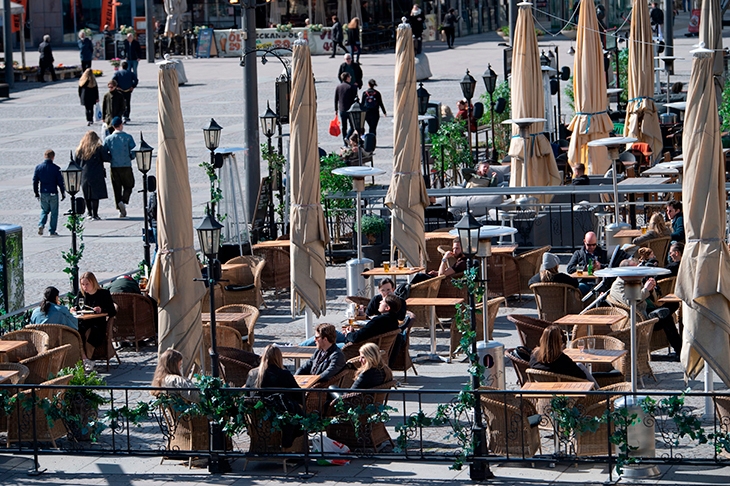Schools might never have closed in the first place had the coronavirus not started in China. Imagine it had started in Sweden. Whoever responded first was going to set the tone for the nations that followed. When we are uncertain about what to do, we look to the behavior of others to guide us.
Imagine walking down a street with a new restaurant on either side (you remember restaurants, right?), and that you do not know anything about either of them. One has some customers inside, the other has none. Assuming you can get a table, you would choose the one with people in it because, in the absence of any prior knowledge about the restaurants, other people provide you with a signal about which to eat in.
But imagine that the first person walking down the street had no idea which one to choose and did so based on a spurious reason, such as preferring a red door to a yellow one. The restaurant with the red door would get all the customers while the one with the yellow door would get none, and this would provide no information at all about which restaurant is better.
Now consider China’s response to COVID-19, which was to lock down Wuhan. It chose the red door of virus suppression and school closures over the yellow door of mitigation and leaving schools open, with the eventual result of herd immunity. It might have done this for spurious reasons so far as mitigating impacts are concerned, for example because it felt bad about being responsible for the virus. But just as people follow others into a restaurant, most countries followed China’s lead.
Now there were of course epidemiologists who advised suppression because it was expected to result in fewer deaths from COVID-19, and so it has a more rational and substantive basis to it than choosing a restaurant simply because of a preference for a red door over a yellow one. But the advice has so far failed to properly account for indirect deaths from the policy and the wider economic and social impacts, such as that on children and the widening inequalities caused by school closures. To decide which restaurant to go to, you would like advice from experts who (analogous to epidemiologists in a pandemic) know about the calorie content of the food — but you would also like to know many other things too, such as what the food tastes like, how many items are on the menu and the price of the meal.
Once short-term deaths from COVID-19 become the yardstick by which policies are judged, it is very difficult to steer a different path. It takes courage to stand out, even if you know you are right, let alone when you can’t possibly know for sure what to do. In a world of uncertainty, it is so much easier to follow the herd and risk being one of many who are wrong than it is to stand out and risk being the only one who is wrong.
For this reason alone, Anders Tegnell, the epidemiologist advising the Swedish government, is to be commended. It is important to note that Sweden, with its low population density, high number of single-person households and high trust in government, does lend itself to voluntary social distancing. And so enforced social distancing might still have been the best outcome for short- and long-term welfare in many countries. But even so, if COVID-19 had started in Sweden and the country hadn’t felt under any pressure to suppress the virus, and if Tegnell had set the tone for how best to respond, it is reasonable to suppose that many more schools would have remained open elsewhere.
Elsewhere but not everywhere. Suppression policies are generally preferred to mitigation ones because they deal more directly with people’s fear of the virus and, relatedly, because they signal that we care about the immediate threat to human life. Mitigation policies address the fear of infection more weakly and lack the power of a virtue signal. Suppression policies might still be more effective, of course, but not for these reasons. When the UK went into lockdown, the public were more than ready for it. In fact, many were clamoring for it on the basis that Italy, Spain, France and Ireland had shown how much they cared about the immediate mortality risks by imposing quite stringent restrictions on personal freedoms.
***
Get three months of The Spectator for just $9.99 — plus a Spectator Parker pen
***
The UK government was not signaling hard enough that it cared about people dying and so, when the lockdown finally came, most of the discussion was around whether the measures were stringent enough, rather than too stringent. In this sense, the UK government initially chose the restaurant with no one in it, but then ran across the street to the one where most of its public were seated. Anyone brave enough to stand against the herd, the fear factor and the virtue signaling to suggest that closing the schools might be a disproportionate response was considered akin to a genocidal maniac.
And so we find ourselves where we are now. Schools are closed and the fear of opening them again looms disproportionately large in many people’s minds. It is time for the government — and the teaching unions — to see past herds, fears and virtue to focus directly on the costs and benefits to the whole of society from its decisions. Based on the balance of evidence from the full range of experts, and accounting for lifetime inequalities, the schools should reopen with a phased return on June 1 because the benefits to children, particularly disadvantaged ones, outweigh the small increase in mortality risks (for predominantly older people) that will result. Measures must be put in place to ensure that they remain open. This will include properly engaging with, and mitigating, people’s fears and their desire to virtue-signal, as well as more practical considerations such as social distancing measures and the appropriate use of PPE.
This article was originally published in The Spectator’s UK magazine. Subscribe to the US edition here.


















